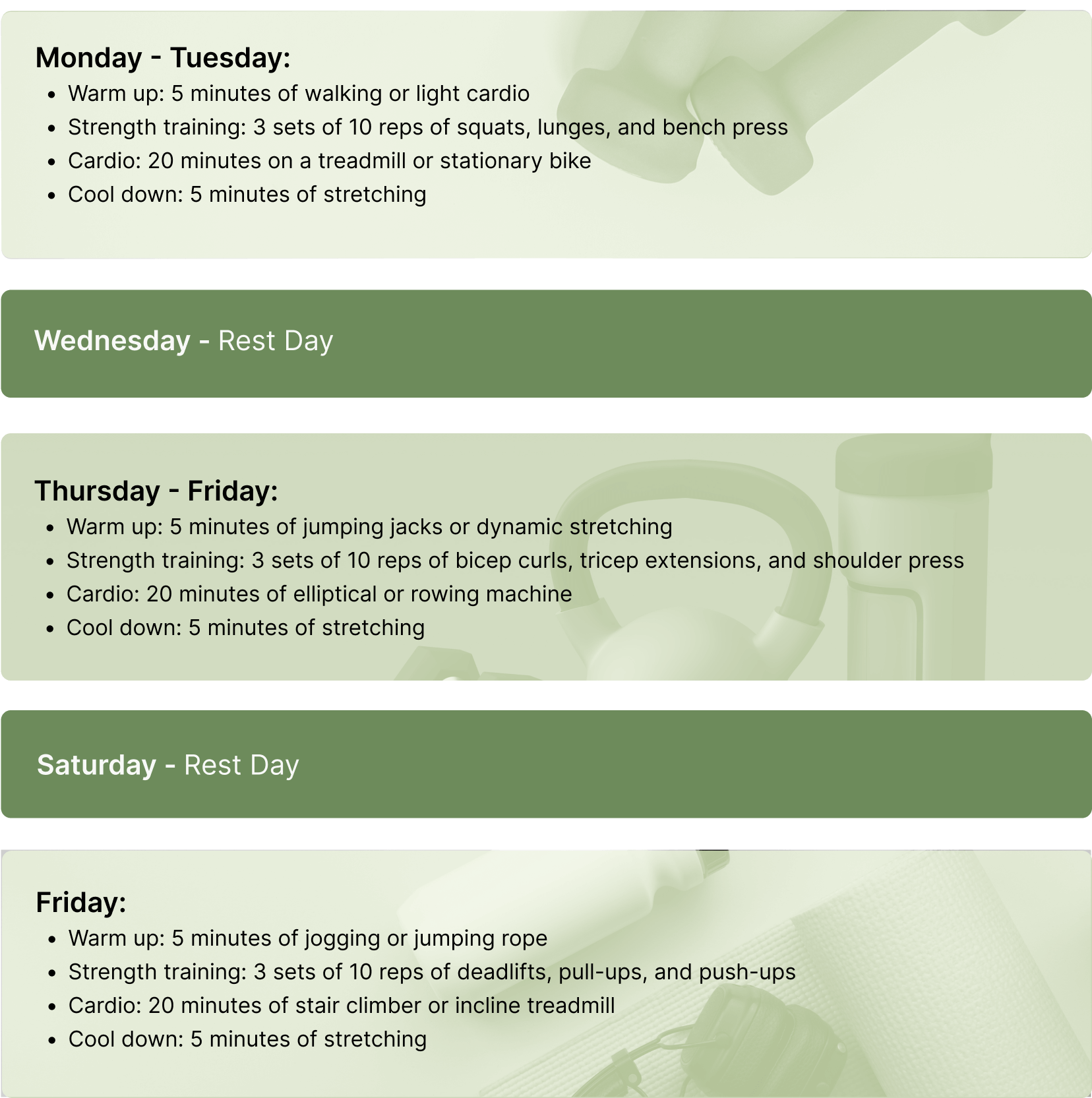Are you thinking of starting your fitness journey but afraid to make mistakes? Don’t worry, we are here to help. Before diving headfirst into a new workout routine, it’s essential to understand common fitness mistakes that beginners make and how to avoid them. In this blog post, we’ll share 7 common fitness mistakes and provide you with tips on how to avoid them. After reading this post, you’ll be well-equipped to start your fitness journey on the right foot and achieve your goals safely and effectively.
7 Mistakes to Avoid When Beginning Your Exercise Routine
1. Not Warming Up Before a Workout
Not warming up before a workout can increase the risk of muscle strains, injuries and reduce the effectiveness of your exercise routine. Warming up before any workout, whether it be cardio or strength training, may seem quite routine, but it actually helps your body get ready for the workout by increasing blood flow and oxygen to your muscles. Here’s a quick warm-up routine that beginners can incorporate into their exercise regimen:
1. Jog in place or do jumping jacks for 2-3 minutes to get your heart rate up and increase blood flow.


2. Do some dynamic stretching exercises, such as arm circles, leg swings, or walking lunges, to help increase range of motion and loosen up you muscles.
3. Practice some simple bodyweight exercises, such as squats, push-ups, or lunges, to help activate the muscles you’ll be using during your workout.

Remember, warming up doesn’t have to be complicated or time-consuming, but it is an important step to help reduce the risk of injury and get the most out of your workout.
2. Over-Training
Many beginners make the mistake of over-training due to today’s all-or-nothing mentality. Some jump right into intense exercise, like running a half-marathon without proper training, which can lead to injury and inability to continue. It’s important to know that gaining muscle and burning fat isn’t as difficult as it seems, and pushing yourself too hard can do more harm than good. Overtraining can cause reduced performance, prolonged soreness, and a higher risk of injury. Working out more doesn’t always mean faster progress, so it’s important to listen to your body and find a balance that works for you. Here’s a beginner-friendly workout routine that can help you avoid over-training:
- Start with a 5-10 minute warm-up, such as light jogging or jumping jacks.
- Perform one or two compound exercises, such as squats or push-ups, for 3 sets of 10-12 reps.
- Follow up with one or two isolation exercises, such as bicep curls or tricep extensions, for 3 sets of 10-12 reps.
- Finish with a 5-10 minute cool down and stretching.
It’s important to gradually increase the intensity and duration of your workouts over time to avoid injury and burnout.

3. Misusing Heavy Equipment
There’s nothing wrong with seeing people working out outside of their comfort zones, but there’s a narrow line between pushing yourself and going too far. It could be harmful and not very sustainable to increase strength and muscle by lifting weights that are too heavy for you (if the added weight interferes with your form and technique, you could seriously hurt yourself). Finding the proper weights that push you while allowing you to retain good form is essential if you want to continue improving and avoid injury.
4. Not Having a Workout Plan
One of the biggest fitness mistakes beginners make when starting out at the gym is exercising without a plan. Many newcomers wander aimlessly around the gym without a set workout routine, which can make it difficult to achieve their desired goals. Fortunately, most gyms, such as Vision Sports Club, offer group programs and personal training sessions to help beginners learn and master exercises while following a predetermined schedule tailored to their individual needs and body type.
Having a workout plan ensures that you’re targeting different muscle groups and giving your body enough time to recover between workouts. A good workout plan should include a combination of strength training, cardio exercises, and rest days to allow your body to recover.
Here’s an example of a sample workout plan for beginners:


Remember to adjust the workout plan according to your fitness level and preferences, and always listen to your body to avoid overtraining or injury.
5. Setting Unrealistic Goals
Setting ambitious objectives can put you back, much like working out too hard. Indeed, establishing personal goals is essential for your success in the gym. You wouldn’t know where to go if you do not have a clear picture of what you wish to achieve from your fitness routine. But, based on your fitness level, you should create goals that you can achieve. Whether you want to run a mile in under eight minutes, put 20 pounds on your bench, or drop 20, you might have to work your way up to these objectives. Setting a goal to increase your strength can be a great way to track your progress in the gym. For example, you could aim to lift a certain weight for a certain number of reps or increase the weight you’re lifting over time.
6. Cheating on Proper Form
Exercising is a highly demanding activity that requires focus, energy, and determination. As many new fitness enthusiasts push themselves to complete a difficult exercise, they often resort to cheating on the proper form in order to achieve their desired number of reps. However, this approach comes with significant drawbacks, as it undermines the effectiveness of the exercise by not targeting the intended muscles and greatly increases the risk of injury. It is important to prioritize proper form over the desired number of reps. Though it may be tempting to cheat, sticking to correct technique will ultimately yield more noticeable improvements and reduce the likelihood of injury.
As a general rule, keep in mind A.C.E. (Abs engaged, Chin in a good position and not over Extending) when performing strength training activities.

7. Taking Long Breaks Between Workouts
Resting between sets is essential to obtain a good workout and prevent damage during strength training. However, taking too long between sets to relax and recover can hamper your development or have negative effects. Aim for 2 to 5 minutes of rest in between sets if you’re performing fewer than 6 to 8 heavy repetitions. Aim for a 30- to 90-second break between sets if you’re performing greater than 8–10 reps. Again, speaking with a skilled personal trainer is always worthwhile because this recovery time can vary depending on the workout and your goals.
Let’s Get Started
Starting your fitness journey can feel overwhelming, but with the right support and guidance, it can be a fun and rewarding experience. At Vision Sports Club, we believe in creating a welcoming and inclusive environment for all fitness levels, including beginners. Our team of qualified trainers is here to help you avoid common mistakes and achieve your goals efficiently. We offer personalised training programs and nutrition coaching to ensure you have everything you need to succeed. Plus, with our state-of-the-art facilities and variety of fitness classes, you can stay motivated and engaged in your fitness routine. Remember, consistency and patience are key, and we’re here to support you every step of the way. Start your fitness journey with Vision Sports Club today, and let’s achieve your goals together!


